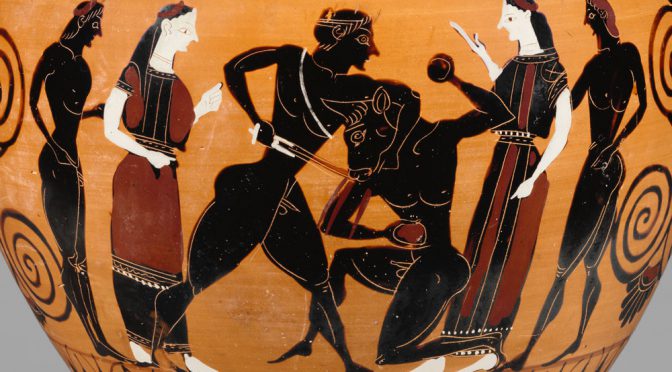In the Alters’ World (and the Agent of Argyre series), creatures of legend reveal themselves to the world. Born through genetic abnormalities, defects and mutations, the Alters have lived for centuries as outcasts of human society, hiding their true nature from the world while colorful stories have been written by many to describe what they’ve seen. How are these creatures different from what was described in the stories? What relationship do they have with humanity? Every entry of the Alterpedia will delve into a new creature from around the world. This week we cover:
Minotaurs
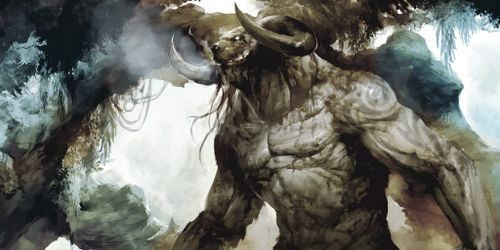
Hidden in the depths of a terrible labyrinth, waiting for new victims as it feasts on those unfortunate to be condemned into its domain, the Minotaur is a fearsome figure of Greek mythology. Having long existed as a singular entity, the product of divine retribution, these bull-human hybrids have since become an entire race of creatures found throughout fantasy. Whether they be descendants of the original, products of similar circumstances, or simply a fantastic race, you can now find Minotaur-like creatures in stories far diverged from the original.
But with the rise of the Alters, new questions now emerge. Which of these depictions is closer to the truth? Was there a Labyrinth? Were they the creation of some act of divine retribution or did they arise the same way all other races did? And, most importantly: are they vicious savages like the creature of the original story or can they be a part of civil society?
Physiology
Mythology
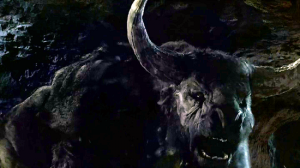
One of many bull-like creatures found throughout mythology, the Minotaur is one of the most instantly recognized for its bovine origins. Though the number of traits it shares with bulls depends on the version of the story told and the interpretation of the artist, what is almost universal is that the Minotaur has the head of a bull and the body of a man. Though sometimes this may include bull-like legs, this is not always present and when it is it tends to be a regional variation, sometimes even including a complete centaur-like body.
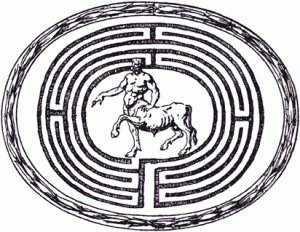
Conventionally, however, it is mostly humanoid in form with the bull head and an incredible physique. Though impressively built, like most figures of Greek mythology, the creature is often not much larger than average humans and is often times depicted as standing at near equal stature to Theseus – the hero known to kill the beast.
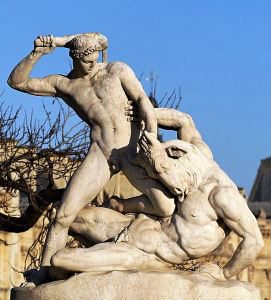
Alters
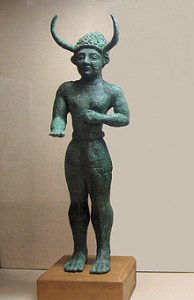
The Minotaur race of Alters is less inhuman than the Greek depiction and more in line with bull-like deities found in nearby cultures. This is by no accident, as the depiction of the creature in Greek mythology was driven greatly by political motives. In actuality, the Minotaur race is best known for their incredibly large, well built forms which reflect a history of military service and struggle. Though not reaching the heights of other races like Giants, the Minotaur do happen to reach heights that would be considered quite large by human standards. However, though quite large, it is another feature which makes them unmistakable.
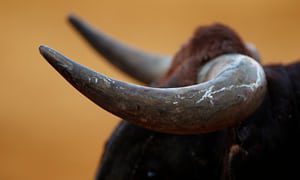
Minotaur horns, generally quite large, broad, and durable are anchored into their relatively thick skulls. However, unlike the bulls they resemble and similar to their cousins the Satyr, these horns are not consisting of bone but instead of incredibly thick layers of keratin. As a result, while shaped and positioned in a way similar to those of bovines, the actual structure of Minotaur horns most closely resembles that of rhinoceroses.
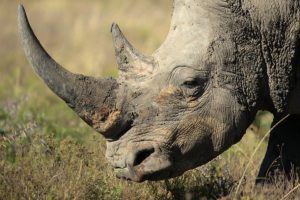
These horns are anchored to a considerably thick skull which may sometimes result in the cow comparisons made by the Greeks. Thick and developed for taking extreme head shots, the skulls of Minotaurs are a bit broader than those of humans and come with heavier jaws which developed to endure potentially dangerous blows. As a result, while naturally appearing human, it is not unusual for Minotaur faces to appear elongated in profile. However, this effect is subtle enough that, without the horns, many people would completely miss the association.
Origin
Mythology
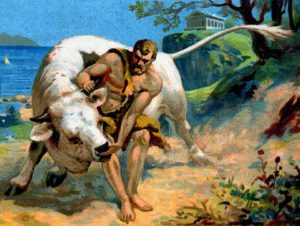
Though the origins of many Minotaurs or Minotaur-like creatures throughout the fantasy genre are often left ambiguous or simply explained as a natural evolution, that is not so true for the original Minotaur himself.
During a conflict with his brothers for the throne, Minos, the future king of Crete, prayed to Poseidon for a show of support. This show of support was to come in the form of a white bull, a creature which would be of obvious divine origin and a sign of Poseidon’s support. Upon receiving it, Minos was then to sacrifice the bull to Poseidon as a show of respect. To everyone’s surprise, Minos received this white bull and was granted the throne over his brothers as someone who had clearly gained the support of the gods. However, Minos wasn’t keen on completing his end of the deal, and decided to keep the spectacular bull for himself rather than sacrificing it.
This was a mistake.
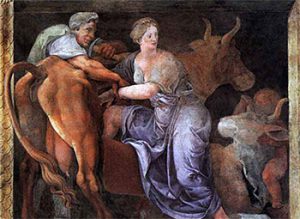
Poseidon, angered by Minos’ defiance, set out to curse Minos for this betrayal and enchanted his wife, Pasiphaë, to make her fall madly in love with the very bull Minos refused to sacrifice. Pasiphaë, now wanting the bull more than anyone, went to the great craftsman Daedalus and had him construct a wooden cow which she could climb inside of and use to mate with the bull. And, after Daedalus completed the wooden cow, Pasiphaë climbed inside and did just that. And the result was a creature that, like white bull before it, couldn’t have come from anywhere but divine intervention.
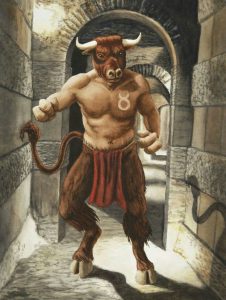
As a child the creature was nursed by his mother, but as he grew he was slowly taken over by his wild instincts and became ferocious, beginning to eat humans. Minos, realizing the situation he was in, went to the oracle of Delphi for advice. Per her guidance, he then returned to Daedalus and had him construct a labyrinth for this creature which would keep it contained and allow them to send prisoners into the labyrinth so they may be devoured by the beast. This would continue for many years until the creature’s death at the hands of Theseus.
Alters
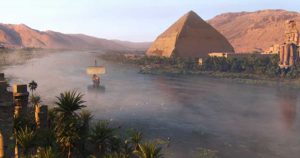
Though the Minotaur of lore has long been associated with the Greeks, the bull-like Alters can trace their lineage back much further than that. Like their distant cousins the Satyr, Faun, Krampus, and other horned races, the Minotaur Alters have their origins in a tribe of First Ones known as the Khnum tribe.
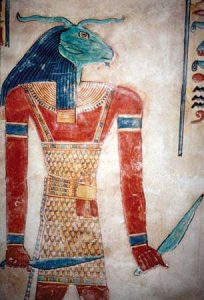
Eventually represented as a singular god, one who is sometimes stated to have fathered Ra himself, the Khnum tribe were an influential group of the First Ones who lived in the regions around what is now known as Lake Victoria. Lake Victoria, also known in local dialects by names such as Nyanza, is one of the largest sources of water to flow into the Nile and, as a result, the Khnum held great sway among the First One Tribes. However, as time went on, particularly with the rise of the Atlantean Empire, one branch became the most influential of the Khnum families – the Apis.
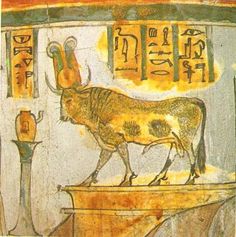
The Apis family, located much further north and closer to the seas, benefited from their location and influence to become something of intermediaries between the various tribes. They facilitated trade, communication, and transport while holding greater control over the Nile itself than the rest of their Khnum relatives. Over time, the two diverged greatly, with the Apis adopting broader forms and thicker horns that made them appear more bull-like in nature. Eventually, this division and the growing influence of the Apis made them recognized as a tribe of their own in Atlantis and were granted control over territories such as the island of Crete and its surrounding territories where they formed the foundations of what would eventually become the Minoan civilization.
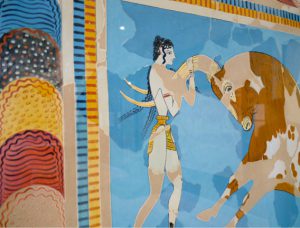
As time went on and the malleable forms of the First Ones gave way to the more stagnant nature of modern Alters, the “Minoan Bulls” or “Minotaur” became a key part of Atlantis’ military power in Europe, Africa, and West Asia. Adapting to become bigger, stronger, and possess greater endurance, the Minotaur became the tip of the spear in many Atlantean campaigns. And, as a result of their function within Atlantis’ civilization as being the face of a powerful but distant entity, Minotaur-like creatures became common in religions throughout their region.
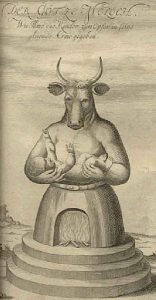
However, as time went on, with the decline of Alter influence in must of the world following a few notable conflicts, the world’s opinion on Minotaurs swung greatly. What once were seen as creatures of divine authority soon became seen as accursed beasts. And, because of this, King Minos of Crete, a descendant of the early Minotaur rulers of the region and latent Alter, found himself in something of a problem. With his wife and he both being latent Minotaurs due to their ancestral ties, their son was born active and presented small horns which could not be missed. Realizing this could expose them for what they are, Minos soon concocted a story which declared his wife had been seduced by a creature sent by the gods and soon sealed his son away in a prison constructed as a Labyrinth to prevent the powerful child from being able to escape. This Labyrinth, originally meant for just the son of Minos, soon became home to dozens of others as Minos began actively persecuting any Minotaur he could find in an effort to hide the truth of his own bloodline.
Behavior
Mythology
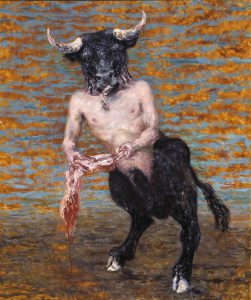
While many cow-like creatures have shown more tame natures, often even helpful or protective, in the many mythologies they appear, the Minotaur of Greek mythology was anything but. Initially raised by its mother much like any human child would be, the creature eventually became overcame with an insatiable hunger and blood lust. Unable to eat any other foods, the Minotaur craved only human flesh and viciously attacked those around it. Needing to contain it and unable to get rid of it, Minos trapped it in a great Labyrinth both to prevent the creature from escaping and to lead others to its grasps.
The Minotaur was obligated to eat these people, as it was said no other food was available to it. However, the number of people it needed to eat is left somewhat vague. The only accounts of how often it needed to be fed range wildly from either 14 young people in a single year to 14 people once every 9 years. In both of these cases the sacrifice was to be as punishment for the Athenians for the death of Minos (other) son. However, no other details are made available on how often the Minotaur might be fed other prisoners.
Alters

Ironically, despite their depiction as man-eaters by Minos and those to follow, the Minotaur race of the modern day tend to be vegan. Though biologically omnivorous, they do have issues with being able to digest sufficient quantities of plants, resulting in many of them to mimic the cow behavior of “chewing cud”. However, despite this inconvenience, Minotaur relations to cattle have been such that many in the modern day feel uncomfortable eating anything that has come from a livestock source. As a result, though uncomfortable and sometimes unusual looking, many Minotaur strive to overcome their digestion problems.
This somewhat pacifist approach is a relatively new development for the Minotaur, as their race had once been dominated in a military culture. The Minotaur biochemistry is actually biased towards heightened aggression, and sudden bouts of temper have historically harmed their reputation in many parts of the world. However, in the days since the Labyrinth the Minotaur culture has evolved to avoid conflict whenever possible. Historically this has resulted in them ritually removing their horns – a process requiring constant maintenance as their horns grow back – in order to stay hidden. However, while this avoidance of conflict was common, many Minotaur still found themselves using their natural strength as mercenaries, enforcers, and gladiators.
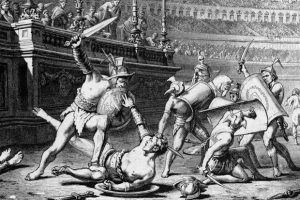
Though many are now becoming more confident in revealing themselves in the modern day, ritual removal of horns is still practiced by orthodox Minotaur society and such horns are often kept for celebratory events like festivals, parties, or religious ceremonies. Though this is in large part unnecessary since the rise of Argyre, the old ways are generally enforced by older generations and many now argue the controversial procedure is unnecessary in contemporary society. However, while the debate still rages on, many in Minotaur society prefer to follow the example of their bovine friends…
And do all they can to avoid their stereotypes.
(I write novels and dabble in screenplays. Follow me on twitter for more world building. I promise I won’t disown you to hide my bovine ancestry.)


